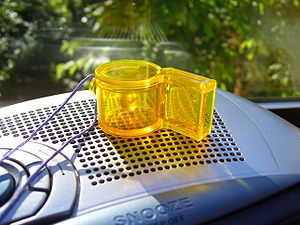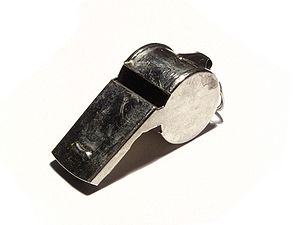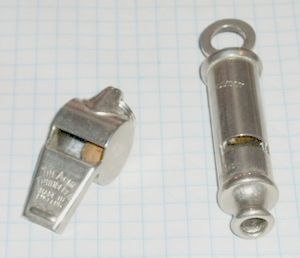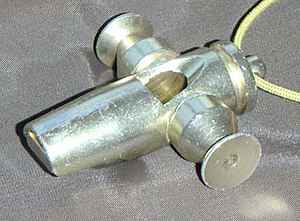AY Honors/Whistles/Answer Key
A whistle is a simple Aerophone, an instrument which produces sound from a stream of forced air.
Whistles are devided to Mouth operated whistles ( Ussualy small ) and none mouth operated whistles ( Air pressure, Steam, mannualy operated, Electronic etc.) mostly tho not always of large construction.
There are also various types of musical whistles from the small slide whistle or nose flute type to the gigantic multi pipes church organ .
For disambiguation it should be noted that many times whistles are refered to as calls, horns, noisemakers and other names, depends on the ussage, Pitch pipe, Bird call, boatswain's call, etc.
It should be noted that whistles were refered to as calls in patents and in old whistle makers catalogs starting 1870s and it was gradually that the name whistle took its place to all kinds. At the 19th century theb term whistles was kept more for use with toy whistles, where Proffesional whistles were reffered to as calls. This is also true for today and many whistles that are used for hunting are stll reffered to as calls, or game calls.
History
whistles have various ussages and thousands of shapes, designs & patents, whistles were used since prehistoric times thru out the world.
The whistle is bassically a call for attention and a mean for comunication, weather it was an army commander, a policeman, a child call for attention ,a lifeguard , a hunter to command its dog, an alarm or siren whistle, a refferee in sports games or a bird calling another.
Since the mid 19th century to WWII, whistles were an integral part of urban life
The whistle has its roots dating back to ancient China. Chinese night watchmen used to blow into the tops of acorns in order to alert the towns of invading Mongolians.Template:Fact
In ancient Egypt two blades of the papyrus plant along the Nile river were held together in between the palms. By blowing into the palms the papyrus leaves would make a loud vibrant sound.Template:Fact
In 1868 Joseph Hudson of Birmingham, England, made the first whistle ever to be used by a football referee. New Zealand referee William Atack was the world's first to use a whistle to stop a game of sport in 1884. It was used for the first time (allegedly) at a game held at Nottingham Forest, prior to this referees used handkerchiefs to attract players' attention.
By 1884, Joseph Hudson had perfected his whistles and he released the world's most successful whistle to date, the "Acme Thunderer" (the first ever pea whistle). The whistle has been used as an alarm or attention-getting instrument by all manner of industries, sports and revellers. It continues to sell in great quantities throughout the world.
Whistle-types
Mouth operated whistles are construction wise devided to two types A & B ;
- Type A includes all whistles made of one major piece; a tubular - pipe cylindrical shape, round eliptical ocarina like or flat rectangular shape chamber and a whistle- window for air outlet, this type may have stop holes or may include some internal mechanism to change sound .
Example of this type are: numerous flute, Game calls, cylinderical general service whistles, round pea whistle,
- Type B includes whistles constarcted of more than one magor part, whistles that are constructed from a sound chamber and another part leading air to it,
(Bosun whistle, escargot- type,Multi chamber, Multi pipe, Water warblers(water whistles) at times whistles of few air chamber pipes and more intricate devices .
Many types exist, from small police and sports whistles (also called pea whistles), to much larger train whistles, which are steam whistles specifically designed for use on locomotives and ships. Although whistles have a musical characteristic (for example train whistles sound a minor-seventh musical chord) whistles are not usually considered "musical" in the sense of being able to play a chosen melody, but mainly the small whistles can also be used as a – very shrill and loud – noise and rhythm instrument. However, musical whistles exist, including any of several 2-octave musical instruments known as tin whistles (sometimes known as pennywhistles or low whistles), as well as the calliope (an array of separately actuable steam whistles), organ pipes and the recorder. Pea whistles are used in jazz and Latin music as a percussion instrument, and children often use them as a toy music instrument.
The whistle works by causing the smooth flow of air to be split by a narrow blade, sometimes called a fipple, creating a turbulent vortex which causes the air to vibrate. By attaching a resonant chamber to the basic whistle, it may be tuned to a particular note and made louder. The length of the chamber typically defines the resonance frequency. A whistle may also contain a small light ball, usually called the pea, which rattles around inside, creating a chaotic vibrato effect that intensifies the sound. Japanese bird whistles use several small balls and are half filled with water in order to reproduce the sound of a bird song.
A steam whistle works the same way, but using steam as a source of pressure: such whistles can produce extremely high sound intensities.
Sometimes, unintentional whistles can be set up. A common one is the opened sunroof of a car: air passing over the top of the vehicle can, at certain speeds, strike the back edge of the sunroof, creating a very low frequency whistle which is resonated by the closed interior of the car. Since the sound frequency is infrasonic, around 4 Hz, the effect is very uncomfortable for occupants, who feel the vibration rather than hear it. Such low frequencies can induce nausea, headache, disorientation and dizziness. The effect can be prevented by opening a side window a few inches. Subsonic whistles have also been developed for use as weapons, or to deliberately create a sense of uneasiness in an enemy.Template:Fact
Various Fields & Usages
Proffesional whistles
Proffesional whistles are whistle-types that are used for Genral services as in Police, Fire Brigade, Army, Mailman serving at the general post office (G.P.O) at one time, railway conductors, guards, wardens, nurses at Asylooms and mental hospitals, custom officers and other goverment services.
Few types of whistles were in use in different countries and periods , the term Genral Service Whistle(GSW), ussually refers to the common british "Boby whistle" a cylindrical two note whistle that was in use from the 1870s in Great Britain and later all over the world.
There are in general 7 basic proffesional types whistles . Round pea whistles, Beaufort whistles (Conical shaped whistle) some times in metal sheeth and called cased beaufort, GSW, Double end whistle or composite whistle that is made of two whsitle joined top to top, all constructed as Type A . Bosun's calls, Escargot-type whistles many times refered to as referee whistle, and Multi pipe or chamber whistles, mostly made of two or more joint pipes with and inline mouthpiece .
Police whistles
In England since the Metropolitan Police Services inception in 1829, officers have been issued with the "Metropolitan" whistle. Prior to this, police used hand rattles,& with whistles only being used as musical instruments or toys. Both rattles and whistles were used to call for back-up in areas where neighbourhood beats overlapped, and following their success in London, the whistle was adopted by most counties in England.
J Stevens & Son & J Dixon & sons made police whistles from around the 1840s, T Yates made Beaufort whistles for the Liverpool Police in the 1870s. The 1880s and 1890s saw police whistles made by W Dowler & Sons, J Hudson & Co, J Barrall, R A Walton,H A Ward, A De Courcy & Co manufactured the same about 1900.
Police whistles fell largely into disuse in some countries in 1969, when early hand-held radios were brought into service. With the rise of the motor car, the whistle was no longer usefully audible in urban areas. The whistle is still used by some police forces today, and engraved ceremonial versions are sometimes presented to police officers upon occasions such as their retirement.
Army
Armies where using whistles ever since roman times (Round type bronze whistles), The later ones of western armies since mid 19th century carry regiment names, Numbers, year date, broad arrow and goverment inspection marks . although the majority of whistles in use were GSWs round pea whistles, Beaufort type and cased beaufort whistles were also common for many years. 19th century armies used the Fife or army pipe, a 2 or 3 holes whistle that could play march music along with a drummer or horn reed type whistles at time with a valve to call for attack.
Bosun's call, also known as Boatswain's call, Bosun whistle, Bo'sun call,Bosun's call, is a traditional instrument believed to exist since roman & greece time for keeping the rowing strokes in pace . In the days of sail boats, orders aboard ship were piped on the Bosun’s Call, whose high-pitched whistle could be heard against the strongest wind.The whistle is still used for the world’s navies and training cadets, thogh ussually more for ceremonial purposes, as when recieveing a high commander .
- The Bosun pipers at ships have a code language consisting of series of long & short notes of various pitches assigning the ships crew to Breakfasts , Dinners, to hoist sails, gather on board or other special missions.( See the page of Boatswain's call for more detalis and references 0
- The bosun call can be manipulated to play any melody using the hand and fingers. Some old sailors are real virtuosos players using the whistle as a musical instrument .
- A Bosun whistle made of gold found under water in a spanish ship that sunk in 1622 by a Florida based treasure hunting company, was recently sold at an auction for & 60,000 .
- Bosun calls are tarditionally made of Silver, Brass and copper .
- A Gold Bosun whistle from Henry VIII's time is displayed at The Chichester Museum in England .
- Today Buson calls by the thousands are sold as at gift & souvenir shops in great harbour cities around the world,
But ones that were in genuine use on ships ussualy carry the ships name, and early ones silver hallmarks of maker and date.
- Silver hallmarked bosun whistles of the 18th and 19th centuries mostly of british makers are rare collector's items.
- The Bosun call is a (Type B whistle)is constructed from few parts ussually refered to as Mouthpiece Gun keel Shackle buoy & Hole .&
Industrial whistles
Industrial whistles are used for signalling and timekeeping both on railroad and ships, and in factories. Most of these whistles were steam powered and not standardized. Individual locomotives could be identified by their whistles. At noontime in industrial areas up into the 1950s whistles of every pitch could be heard, as each factory had a boiler and a whistle, if not full steam power.
Railroads in particular used elaborate whistle codes for communication both within the train and with other trains. These methods are maintained today with motor-powered air horns. Trucks also use air horns, especially since they often have air brakes and so there is already a source of compressed air on board.
Train whistles generally produce three or four different frequencies at the same time to produce a non-major chord that is distinct, loud, and low in pitch.
Ship's whistles must be very loud for safety on the seas. Modern ship's whistles can be electrically or steam driven. Template:RMS was originally equipped with three electric Tyfon whistles in 1932. They could be heard at least ten miles away and were tuned to 55 Hz, a low bass A note that was chosen for maximum passenger comfort despite the high sound pressure level.& One of the three whistles was taken back to Kockum Sonics in Malmö, Sweden, where it was refurbished for a new life of service aboard the RMS Queen Mary 2. Modern IMO regulations specify ships' whistle frequencies to be in the range 70-200 Hz for vessels that are over 200 meters in length.& Traditionally, the lower the frequency, the larger the ship. The Queen Mary 2, being 345 meters long, was given the lowest possible frequency (70 Hz) for her regulation whistles which means she carries both 70 Hz modern whistles and a single vintage 55 Hz whistle.
Safety
Whistles are often used as warning devices or as safety devices serving to attract attention to the user. Some cyclists use a whistle as a substitute for a bell or horn. It should be noted, however, that many jurisdictions require that the warning device be permanently attached to the bicycle.
Rescue or survival whistles are often packed in survival kits and attached to personal flotation devices to allow a victim to signal for help. The whistle is audible at much greater distances than the human voice, and is less likely to cause exhaustion if used repeatedly. Survival whistles differ from pea whistles in that they are usually flat, so that water cannot collect inside if the user is immersed, for example after falling overboard from a boat.
Whistles can also produce sounds at pitches inaudible to the human ear such as dog whistles which can be heard by dogs at a range beyond that of human sensory perception, or at least conscious perception.
Transportation
Sporting
Whistles are used by referees to officiate sporting matches. The whistle was first used to stop a sports match by William Atack in an 1884 game of rugby in New Zealand. Before that game referees used their voices to control play.
Some sports use different types of whistles, but one used around the world in many sports is the Fox 40, a pealess whistle which creates sound using air pressure only.
The Fox 40 is used in Basketball, Hockey, Ice Hockey, Soccer and numerous other games, as it can be heard easily over the noise of the audience.
Another whistle widely used for sports such as Touch Football, Rugby League and Rugby Union is the Thunderer 58.5 by Acme Whistles. It is a metal whistle containing a cork pea. It is used mainly because of its design that allows the user to create a deep, low-pitch shrill that can be heard from hundreds of meters away.
Toys
Ever since the dawn of history children were given whistles that served there natural instinct to call for attention, archeological finds in many areas in the middle east greece, ancient rome, china and south america show bird shaped clay whistles that were made as toys. we can only assume that whistles made of other materials were made but these did not last. Water Warblers or water whistles from ancient times were found as well, and since the 17th century there are many that survived with collectors and museums.
Penny toy whistles and toys developed in the U.S.A with patents issued as early as 1850s and in france and germany a whole industry developed making children toys and whistles of all kinds.
Since the development of Plastics and industrial manufacturing in the 1930s we can find hundreds of patents ande thousands of toy whistles that apeal to collectors. The 1950s and 60s brough about an endless stream of whistles made in about every western country and in growing quantities from Hong Kong, china, Taiwan, Korea & japan .
Hunting
Hunters used whistles that immitate animal's & bird calls since at least the 17th century . Bird calls & other animal's call are used by proffesional hunters and were use by the upper class extensively for fox hunting and game call which were considered as sports . Duck calls, Goose call, Fox call, Owl hooters, Dove calls,are some of the more common ones . There also bird call whistles that are operated by a clock work mechanism as in Cookoo clocks or hand operated based on friction .
Ethnic whistles & Folk art
Most of the old cultures from Africa to South America, from China to North America every ethnic culture had it's traditional whistles drums and noisemakers to use for dance music and rituals. These types are usually made from organic materials or clay and carry characteristics of local arts, designs and musical heritage.
Ornamental - Jewels
Whistles made as jewelery were a popular demand from the 18th todate, silversmiths mostly in france germany and england & U.S.A mostly, though in other countries as well, were making these for the upper classes. later on in the 20th century various whistles some of cheaper made were popular and are still made .
Music
The whistle is used in samba percussion groups as a leader help to catch the percussionnist attention. The traditional samba whistle has three tones, but as the number of musicians rises in the percussion section, pealess whistles became more popular due to their high pitch and their loud sound. The Slide Whistle or Swanee whistle, was a common instrument in some types of music and popular as a musical effect on earl radio days and in Films & T.V. music.
Pitch pipes are reed whistles used to help in tunning musical instruments and are common since the 1850s .
Others
From shepherds whistles and "Swiss warblers" to whistles combined with swords which were used by the Mongolians to scare their enemies to Chinese pigeon whistles and to japanese & chinese Kite whistles .
Materials
Mouth - whistles are made of 10 basic materials including ;
- A) Metal silver & gold,
- B) Organic materials ( Bone, horn, ivory, Vegetable ivory animal tooth.
- C) Wood .
- D) Clay.
- E) Stone & Minerals
- F) Polymers, ( Plastic , Bakelite , Celluloid, Vinyl Etc.
- G) Rubber .
- H) Paper , Card board .
- I) Glass.
- J) Water whistles combinning one or more of these materials and some involve the addition of water to work .Water whistles ,or water warblers.
Manufactureres
Template:Col-begin Template:Col-2 England, British makers;
- S Auld
- J Barrall
- Bent & Parker
- Black & Co.
- Coney & Co.
- A De Courcy & Co
- J Dixon & Sons
- W Dowler & Sons
- G & J W Hawksley
- J Hudson & Co
- J Linegar
- S Mordan
- J Stevens & Sons
- R A Walton
- H A Ward
- Rudd Bros.
- H & T
- Smith & Wright
- Jensen & Co.
- T Yates
Template:Col-2 U.S.A.
- Bridgeport Gun & Implement Co. (B.G. I)
- B & R
- Ludwig & Ludwig
- Horstmann Philadelphia
- Overmann Wheel Co.
- Perco Philadelphia
- F L Johnson
- Wilson
- Unioun HDW Co.
- Reach
- Frank Holton & Co.
- Kirchoff
- The Pettibone Brs. Manufacturing Co.
- North Bros. Phila.
- American Whistles Co.
- Iver Johnson Co.
- Mossberg Wrench Co.
- Colsoff Ohio
- Seron MFG. Co.
Template:Col-2 France
- Baduel
- Manufacture Francaise D'arms Saint Etienne
- Elless ( M Truffart )
- H Nicolas
- Antonin Louis
- Jean Raymond
- Verney-Carron
- Januel
- R Riflo
- A Saint Hubert
Germany
- Calura
- Clejuso (Clements & Jung)
- Duetsche Signal Instumenten Fabrik Markneukirchen
- Firma Crone& Co.(Van Der Crone)
- Hubertus
- J H Zimmermann Liepzig
Japan
- Maruanaka
- Matbutani
- Noble whistles
- Seizo
It should be noted that this is partial list and beside many other makers there are makers known in most of the European countries to many in Asia South America Australia & The Far East.
Patents & Inventors
Collecting whistles & research
References
- ↑ Taylor, J. "The Victorian Police Rattle Mystery" The Constabulary (2003)
- ↑ (1)
- ↑ The Voice of the Queen Mary
- ↑ Kockum Sonics: Tyfon product IMO regulations
External links
de:Trillerpfeife es:Silbato eo:Fajfilo fr:Sifflet gl:Chifre id:Peluit it:Fischietto nl:Scheidsrechtersfluitje ja:ホイッスル pl:Gwizdek pt:Apito ru:Свисток scn:Friscalettu simple:Whistle sr:Звиждаљка fi:Pilli sv:Visselpipa tl:Silbato vec:Fiŝċiòt




